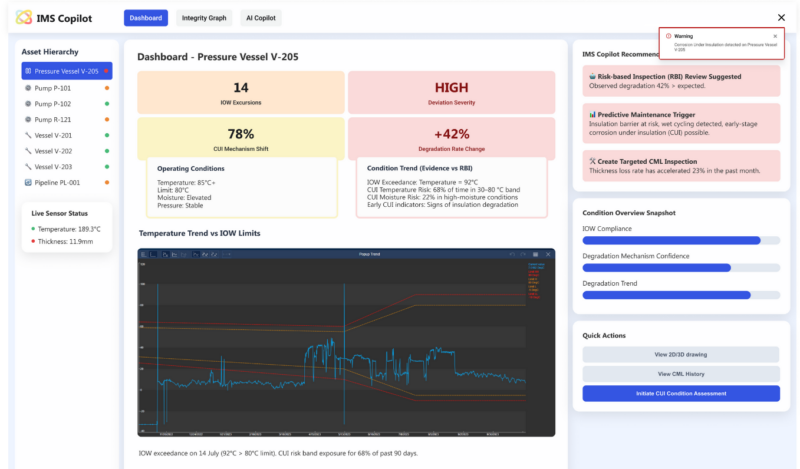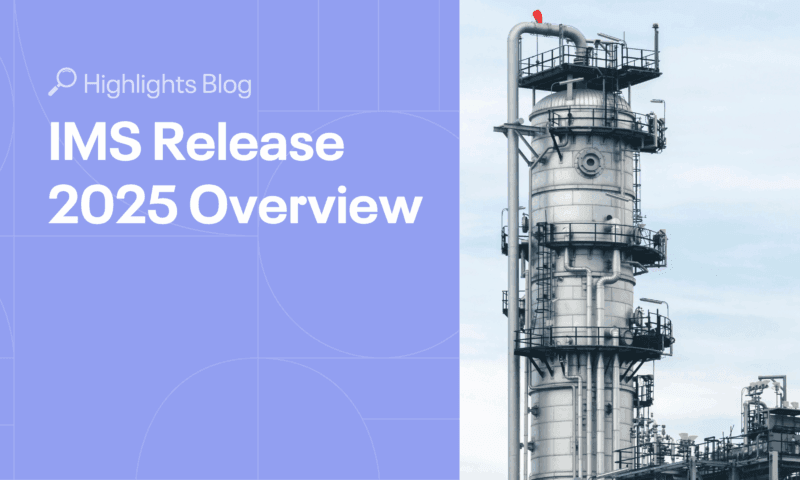Not all equipment damage happens overnight. Sometimes, however, it does.
In oil & gas, chemicals, and other asset-heavy industries, shifts in operating conditions – such as high pressure conditions, or temperature deviations – can dramatically erode the health of your assets. It’s critical to understand how different types of equipment respond to deviations in operating conditions.
If your inspection and monitoring programs are not keeping track of those parameters, irreparable damage to equipment can occur, leading to costly downtime and impacts to health, safety, and the environment.
That’s why asset integrity management systems employ Integrity Operating Windows (IOWs). When defined and monitored properly, IOWs act like guardrails, allowing operators to identify deviations early and to keep assets running safely and reliably.
What Are Integrity Operating Windows (IOWs)?
Every piece of industrial equipment is selected with specific operating conditions in mind, such as temperatures and pressures that shouldn’t be exceeded, and flow rates that must remain steady.
When equipment operates within these parameters, degradation to equipment is usually predictable and manageable. But when those boundaries are crossed, even briefly, in some cases, the potential for equipment failure rises sharply.
Integrity Operating Windows (IOWs) are pre-defined limits for these critical process variables. They act as guidelines for safe and optimal operations, ensuring that conditions do not drift into ranges where asset integrity could be compromised.
API RP 584 is the main standard that discusses how to establish and implement IOWs in risk-based inspection programs.

Examples of IOWs in practice:
- Temperature limits: Preventing high-temperature corrosion or creep, or thermal shock.
- Pressure limits: Avoiding mechanical failures due to brittle fracture or fatigue related to overpressure situations.
- Flow rates: Reducing the risk of under-deposit corrosion or fouling, or preventing erosion corrosion.
- Chemical composition: Controlling contaminants that could lead to corrosion or stress corrosion cracking.
Why IOWs matter
Unlike alarms set purely for process control or safety (such as shutdown conditions), IOWs focus specifically on protecting the long-term integrity of assets. Their main goal is to prevent unexpected damage from occurring in the first place.
By staying within IOW limits, companies can:
- Extend the lifespan of critical equipment
- Avoid unexpected failures
- Reduce unplanned downtime and repair costs
- Improve safety and regulatory compliance
In short, IOWs are not just about running the process smoothly today – they’re about ensuring your equipment remains reliable tomorrow, next year, and for years to come.
Why Are IOWs Essential for Asset Reliability?
- Early Warning System
- IOWs offer near real-time alerts when process conditions drift outside safe ranges, giving operators a chance to act before damage occurs or to trigger early inspections of equipment subjected to abnormal operating conditions.
- Optimize Maintenance Efforts
- By differentiating between critical and non-critical exceedances, IOWs can help prioritize inspection activities and reduce unnecessary downtime and expenses.
- Inform Smarter Decision Making
- Historical exceedance data can enhance future planning, design, and asset life predictions.
The Challenges of Managing IOWs
Establishing and keeping track of IOWs for a facility with tens or hundreds of thousands of pieces of equipment is a daunting task. Without the right tools, support, and knowledge inspection and maintenance programs can become fragmented and inefficient.
Data may be scattered across spreadsheets, control systems, and reports, making it impossible to identify and manage critical exceedances, ultimately leading to equipment failure and downtime.
Even when exceedances are detected, limited visibility makes it hard to connect them to appropriate corrective actions. This lack of integration and oversight weakens reliability programs and ultimately increases the risk of avoidable failures.
IOWs in Practice
The use of Integrity Operating Windows is not a “nice to have” for asset-heavy industry. In fact, IOWs are a core component of any risk-based inspection program.
To successfully implement a risk-based inspection system, you need to be able to identify all of the potential age-related and non-age-related damage mechanisms for your equipment.
Next, you need to be able to identify the appropriate integrity operating windows for each of those damage mechanisms. You also need to be able to integrate your monitoring data into your asset integrity management system.
Finally, you need to be able to easily monitor the status of those IOWs and adjust your equipment inspection schedules based on the information.
Turn IOWs Into a Reliability Advantage with IMS
Fortunately, there is a solution to the challenge of establishing and managing a risk-based inspection program.
Cenosco’s Integrity Management System (IMS), brings all your asset integrity data together into one platform, giving you the tools to manage IOWs, inspections, maintenance, and risk in a connected and streamlined system.
IMS makes managing IOWs much simpler and more effective. Instead of tracking exceedances manually or reacting after the fact, customizable dashboards and other tools allow you to monitor for exceedances, get early warnings of failure, and easily create inspection schedules in one location. This not only helps with day-to-day reliability but also supports long-term maintenance planning and compliance.
With IMS, IOWs become more than just numbers in a spreadsheet — they become an active part of your integrity strategy, helping you protect assets, avoid downtime, and make better decisions for the future.
Request a Demo
See IMS in action




